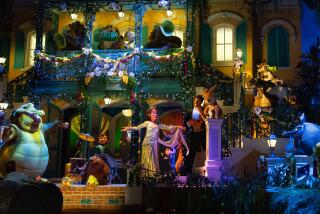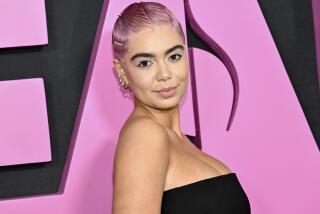Review: Disney’s gorgeous ‘Moana’ offers sweet relief to audiences looking for an escape from everyday reality

Justin Chang reviews Disney’s latest animated movie, “Moana,” starring Auli’i Cravalho and Dwayne Johnson. Video by Jason H. Neubert
Our politically charred landscape has provoked more discussion than usual of safe spaces — those zones of physical, cultural and ideological refuge that are typically spoken of with either earnest sincerity or harsh derision. The Twitter-fueled brouhaha around a recent performance of the Broadway musical “Hamilton,” where Vice President-elect Mike Pence found himself booed by the audience and publicly called out by a member of the cast, turned the very notion of a safe space on its head: Whose sanctuary was being intruded upon? Who was in violation?
That debate will be continued, though probably not concluded, in a different forum. Still, my thoughts kept returning to it not long after I saw Disney’s “Moana,” and not just because this bright, bouncy, insistently enchanting computer-animated fantasy features a soundtrack of songs co-written by Lin-Manuel Miranda — the chief creative force behind “Hamilton” and a current poster child for the sort of popular art that knows no racial, historical or imaginative boundaries.
In short, any theater showing “Moana” — a movie steeped in ancient Polynesian folklore and bronzed to a shiny, state-of-the-art Disney polish — probably represents the safest space you could possibly find in this holiday moviegoing season. Audiences in search of bright colors, easy jokes and family-friendly vibes will find sweet relief here from the drunken, misanthropic high jinks of “Bad Santa 2.” Those seeking a vacation from everyday reality without springing for that last-minute island getaway will scarcely believe their good fortune.

The trailer for Disney’s “Moana,” starring the voice of Dwayne Johnson.
At the simplest level, the endangerment of a safe space — a simpler term for it would be “home” — forms “Moana’s” very premise. Written by Jared Bush (in his second Disney-produced screenplay of the year, after “Zootopia”), the movie begins on the beautiful South Pacific island of Motunui, where, mere minutes after providing a buoyant musical introduction to their lush agrarian paradise, the villagers suddenly find their way of life threatened by crop disease and fish shortages.
The only way to restore the natural order is to locate the shape-shifting Hawaiian demigod Maui and make him restore the Heart of Te Fiti, a magical artifact that he stole centuries ago, setting the present blight in motion. That task ultimately falls to Moana (voiced by newcomer Auli’i Cravalho), a young woman whose headstrong, adventurous spirit chafes against the restrictions of her father, the village chief (Temuera Morrison).
If that daddy-daughter dynamic sounds familiar, it may have something to do with the fact that “Moana” was directed by John Musker and Ron Clements, best remembered for a very different oceanic fantasy called “The Little Mermaid.” Musically, lyrically and dramatically, their new picture doesn’t reach the soaring heights of that 1989 hand-drawn classic, which helped launch Disney’s ’90s new-wave animation renaissance.
Nearly 30 years later, “Moana” follows “Tangled” and “Frozen” in a newer wave of cleverly refurbished fairy tales, reinventing the company line with CG animation, self-referential humor, slyly feminist attitudes and other contemporary amenities.
In other words, “Moana,” like most seemingly innocuous mainstream diversions, has its own undeniably political dimension. As both a gentle ecological parable and the first Disney cartoon showcase for a Polynesian cast since “Lilo & Stitch” (2002), it could scarcely be otherwise. And as with Musker and Clements’ previous film, “The Princess and the Frog” (2009), which featured a rare African American heroine in a 1920s New Orleans setting, a conscientious effort to diversify the company stable has already met with appreciation and trepidation alike.
Some have already voiced their opposition to the fact that Maui, usually depicted as a fairly trim, nimble figure, has here been inflated to proportions more appropriate to Shrek or a sumo wrestler. To argue that the character perpetuates stereotypes of long-haired, heavily tattooed, plus-sized Polynesian masculinity strikes me as both valid and (as is sometimes the case with chiefly race-based critiques) faintly inadequate, not least because it misses the singular comic gusto of Dwayne Johnson’s performance.
Not unlike Robin Williams’ Genie in “Aladdin,” another Musker-Clements creation, Maui is a boisterous agent of show-stopping supernatural chaos. The movie has fun with the visual contrast between its two leads, but if anything their difference in temperament — he mocks her youthful inexperience, she scorns his arrogance and selfishness — is even greater, providing the primary source of tension in a fairy tale without an Ursula-caliber villain.
There is, instead, a fleet of pint-sized, coconut-armored pirates and an angry, fire-throwing lava monster. There is also a giant crab named Tamatoa (voiced by Jemaine Clement), a preening narcissist whose big, David Bowie-channeling musical number, performed in the depths of a bioluminescent grotto, provides the movie with its most arrestingly surreal set piece.
Despite the occasional lapse into anachronistic, self-aware humor, “Moana” for the most part displays a welcome restraint. The intellectually challenged rooster that fills the obligatory animal-sidekick role wisely, and hilariously, never says a word. In an especially inspired touch, Moana’s other silent ally here is the ocean, whose playful, often life-saving interventions bring new meaning to the expression “friendly wave.” (“Moana” would be a noteworthy achievement for its sparklingly vivid animation of water alone; there are moments here that make you long to see the filmmakers tackle the parting of the Red Sea.)
Despite their differences, Moana and Maui turn out to need each other desperately, though that need is refreshingly platonic in nature. While Maui remains haunted by emotional scars from his ancient past, Moana ponders the uncertainties of the future, questioning her ability to shoulder her mighty destiny. For the viewer, at least, that ability is never in doubt, which is both a testament to the character’s strength and a sign of the film’s adherence to formula — a formula that is no less obvious for being executed so skillfully.
Nowhere is this more apparent than in the songs (written by Miranda, Opetaia Foa’i and Mark Mancina), many of which are deeply transporting even when their narrative function follows a fairly standard template. Listening to Cravalho croon her way through the self-directed musical pep talk “How Far I’ll Go,” your pleasure is only slightly tempered by the vague sense that you’ve heard a version of it before — “Part of Your World,” perhaps, or “Reflections” from “Mulan” — and it won’t be too long before you hear it again.
That’s cause for more cheer than disappointment. The moral of “Moana” is that playing it safe can have its limits. It’s hard not to agree, even when this lovely, reassuring hug of a movie doesn’t entirely heed its own advice.
------------
‘Moana’
MPAA rating: PG, for peril, some scary images and brief thematic elements
Running time: 1 hour, 53 minutes
Playing: In general release
See the most-read stories in Entertainment this hour »
Movie Trailers
ALSO
Dwayne Johnson gets animated in Disney’s Polynesian musical adventure ‘Moana’
Dwayne Johnson sings a Lin-Manuel Miranda song in the new ‘Moana’ clip
Disney pulls ‘Moana’ costumes for children amid cultural appropriation uproar
More to Read
Only good movies
Get the Indie Focus newsletter, Mark Olsen's weekly guide to the world of cinema.
You may occasionally receive promotional content from the Los Angeles Times.











